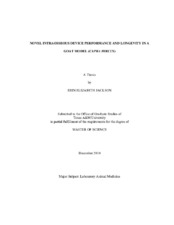| dc.description.abstract | Two studies were performed to assess the function and longevity of a novel
intraosseous (IO) catheter device. For the initial study, nine animals were assigned to
three study groups. The first group received a 25 mm intraosseous device within the
proximal humerus, the second group within the proximal tibia, and standard jugular
catheters were placed in the final control group. Serial aerobic and anaerobic blood
cultures were collected from jugular veins at day zero, then every third day while
devices remained in use. Radiographs were obtained immediately after placement and
again after removal of all IO devices. Goats were observed for overall clinical condition
and lameness associated with catheter sites, and catheters were evaluated for patency and
proper positioning. IO devices in the tibia remained in for less time than those in the
humerus. Blood cultures in this study showed growth of Bacillus, Staphylococcus, and
one colony within the genera Brachyacterium or novel Dermabacteraceae. Catheters
also showed growth of Bacillus, as well as a single colony of Micromonospora chalcea.
No animals in either IO group exhibited radiographic evidence of resulting damage or
structural change within surrounding bone. In study two, eighteen goats were assigned to two study groups (25 mm intraosseous device within the wing of the ilium, or 45 mm
catheter in the proximal humerus). Blood for serial aerobic and anaerobic blood cultures
and CBC were collected from jugular veins at day zero, then every second day thereafter
while devices remained in use. All clinical monitoring and removal criteria were
identical to study one. Catheters in the ilium remained in significantly less time than
those in the humerus. Several animals in the proximal humerus group demonstrated
moderate lameness following removal. One goat developed an abscess near the insertion
site and showed radiographic evidence of periosteal bone growth. Serial cultures
showed growth of Bacillus, Streptococcus, Staphylococcus, and Enterococcus.
Bloodwork indicated mild elevations of white blood cells from baseline in some cases.
Our study indicated that catheters may remain safely in place for greater than 24 hours,
but that animals should be closely monitored for negative side-effects for several days
during the post-removal period. | en |


